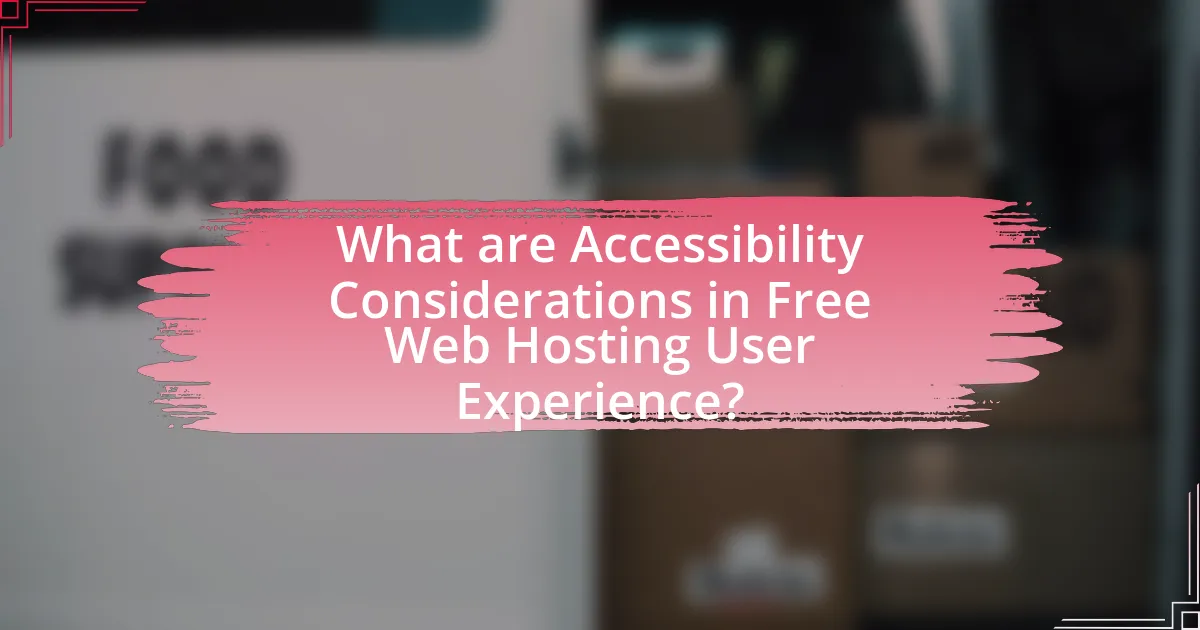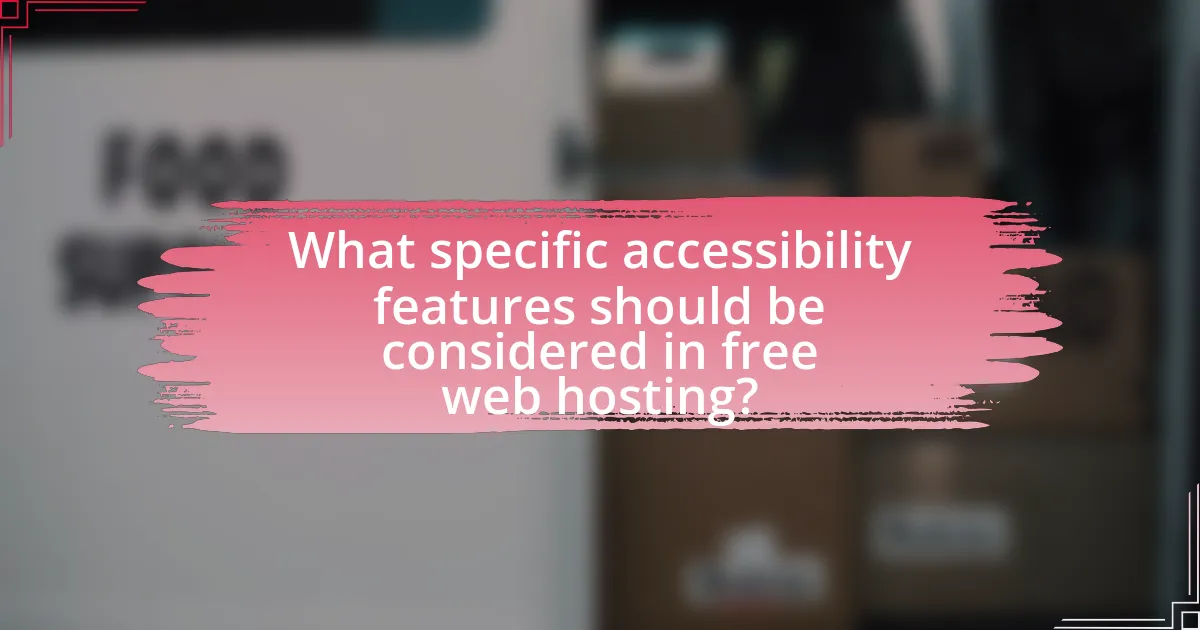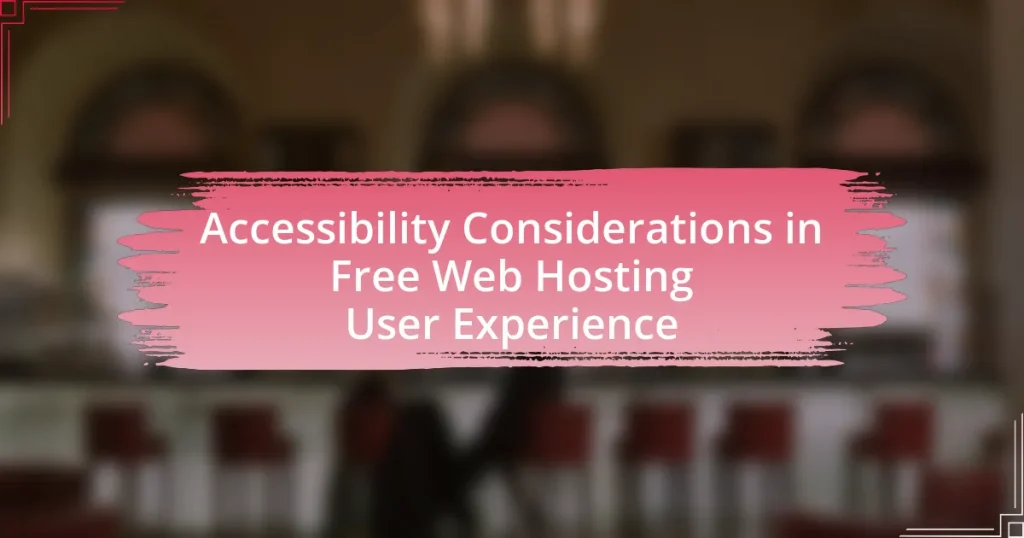Accessibility considerations in free web hosting user experience focus on ensuring that websites are usable by individuals with disabilities, adhering to standards such as the Web Content Accessibility Guidelines (WCAG). The article outlines the importance of accessibility in web hosting, highlighting key principles like Perceivable, Operable, Understandable, and Robust (POUR), and discusses the challenges users face, including limited resources and technical support. It emphasizes the role of web hosting providers in enhancing accessibility features, legal requirements for compliance, and best practices for users to create accessible content. Additionally, the article explores future trends in accessibility, the impact of technology, and practical tips for improving user experience in free web hosting environments.

What are Accessibility Considerations in Free Web Hosting User Experience?
Accessibility considerations in free web hosting user experience include ensuring that websites are usable by individuals with disabilities, which involves compliance with standards such as the Web Content Accessibility Guidelines (WCAG). These guidelines emphasize the importance of text alternatives for non-text content, keyboard navigability, and sufficient contrast between text and background colors. Research indicates that approximately 15% of the global population experiences some form of disability, highlighting the necessity for inclusive design. Furthermore, free web hosting services often lack robust support for accessibility features, which can hinder users’ ability to create compliant websites. Therefore, it is crucial for free web hosting providers to prioritize accessibility to enhance user experience for all individuals.
Why is accessibility important in web hosting?
Accessibility is important in web hosting because it ensures that all users, including those with disabilities, can access and interact with websites effectively. By adhering to accessibility standards, web hosting providers can enhance user experience, increase audience reach, and comply with legal requirements such as the Americans with Disabilities Act (ADA). Research indicates that approximately 15% of the global population experiences some form of disability, highlighting the necessity for inclusive web design. Furthermore, accessible websites can improve search engine optimization (SEO) and overall site performance, benefiting all users.
What are the key principles of web accessibility?
The key principles of web accessibility are Perceivable, Operable, Understandable, and Robust, often referred to as the POUR principles. Perceivable means that information and user interface components must be presented in ways that users can perceive, such as providing text alternatives for non-text content. Operable indicates that users must be able to operate the interface, which includes ensuring that all functionality is available from a keyboard. Understandable emphasizes that information and operation of the user interface must be understandable, meaning that text should be clear and consistent. Robust signifies that content must be robust enough to be interpreted reliably by a wide variety of user agents, including assistive technologies. These principles are foundational to the Web Content Accessibility Guidelines (WCAG), which aim to make web content more accessible to people with disabilities.
How does accessibility impact user engagement?
Accessibility significantly enhances user engagement by ensuring that all users, regardless of their abilities, can interact with a website effectively. When websites are designed with accessibility in mind, they accommodate a broader audience, including individuals with disabilities, which leads to increased user satisfaction and retention. Research indicates that accessible websites can improve user experience metrics; for instance, a study by the Web Accessibility Initiative found that users with disabilities are more likely to engage with content that is easy to navigate and understand. This inclusive approach not only fosters a sense of belonging but also encourages repeat visits, ultimately driving higher engagement levels across diverse user groups.
What challenges do users face with free web hosting accessibility?
Users face several challenges with free web hosting accessibility, primarily including limited resources, lack of technical support, and potential downtime. Limited resources often manifest as restricted bandwidth and storage, which can hinder website performance and accessibility for users. Additionally, the absence of reliable technical support can leave users without assistance when encountering issues, making it difficult to resolve accessibility problems. Furthermore, free web hosting services may experience frequent downtime or slower loading speeds, negatively impacting user experience and accessibility. These factors collectively contribute to a less reliable and accessible web hosting environment for users.
What common barriers exist for users with disabilities?
Common barriers for users with disabilities include inaccessible web design, lack of assistive technology compatibility, and insufficient alternative text for images. Inaccessible web design often fails to accommodate screen readers or keyboard navigation, making it difficult for users with visual or motor impairments to interact with content. Additionally, many websites do not support assistive technologies like screen magnifiers or voice recognition software, limiting usability for individuals with disabilities. Furthermore, the absence of alternative text for images prevents users with visual impairments from understanding visual content, which is crucial for an inclusive web experience. These barriers highlight the need for improved accessibility standards in web hosting and design.
How do different devices affect accessibility in web hosting?
Different devices significantly affect accessibility in web hosting by influencing how users interact with websites. For instance, mobile devices often have smaller screens and touch interfaces, which can complicate navigation and readability compared to desktop computers with larger displays and precise input methods. Research indicates that approximately 54% of global web traffic comes from mobile devices, highlighting the necessity for responsive design to ensure accessibility across platforms. Furthermore, varying operating systems and browsers can lead to inconsistent rendering of web content, impacting user experience. Accessibility features, such as screen readers, may also perform differently depending on the device, affecting users with disabilities. Therefore, optimizing web hosting for diverse devices is crucial for enhancing overall accessibility.
What role do web hosting providers play in accessibility?
Web hosting providers play a crucial role in accessibility by ensuring that websites are available and functional for all users, including those with disabilities. They influence factors such as server uptime, loading speed, and compliance with accessibility standards like the Web Content Accessibility Guidelines (WCAG). For instance, hosting providers that offer Content Delivery Networks (CDNs) can enhance loading times, which is vital for users with slower internet connections or assistive technologies. Additionally, some hosting services provide tools and support for implementing accessibility features, thereby facilitating a more inclusive web experience.
How can hosting providers improve accessibility features?
Hosting providers can improve accessibility features by implementing web content accessibility guidelines (WCAG) to ensure their platforms are usable for individuals with disabilities. By adhering to these guidelines, hosting providers can enhance text readability, provide alternative text for images, and ensure keyboard navigability. Research indicates that approximately 15% of the global population experiences some form of disability, highlighting the necessity for inclusive design. Furthermore, integrating assistive technologies, such as screen readers and voice recognition software, can significantly enhance user experience for those with visual or mobility impairments.
What are the legal requirements for accessibility in web hosting?
The legal requirements for accessibility in web hosting primarily stem from the Americans with Disabilities Act (ADA) and Section 508 of the Rehabilitation Act. These laws mandate that websites must be accessible to individuals with disabilities, ensuring equal access to information and services. The ADA has been interpreted by courts to apply to websites, meaning that businesses must take steps to make their online content accessible. Section 508 specifically requires federal agencies to make their electronic and information technology accessible to people with disabilities. Compliance with the Web Content Accessibility Guidelines (WCAG) is often used as a standard to meet these legal requirements, as these guidelines provide a framework for making web content more accessible.
How can users evaluate the accessibility of free web hosting services?
Users can evaluate the accessibility of free web hosting services by examining several key factors, including compliance with web accessibility standards, ease of navigation, and availability of support resources. Compliance with standards such as the Web Content Accessibility Guidelines (WCAG) ensures that the service meets essential accessibility criteria. Users should also assess the user interface for intuitive navigation and the presence of features like alt text for images and keyboard navigation options. Additionally, the availability of customer support, including documentation and assistance for users with disabilities, is crucial for determining overall accessibility. These factors collectively provide a comprehensive evaluation of how accessible a free web hosting service is for all users.
What tools and resources are available for assessing web accessibility?
Various tools and resources are available for assessing web accessibility, including automated testing tools, browser extensions, and comprehensive guidelines. Automated testing tools like WAVE and Axe provide immediate feedback on accessibility issues by scanning web pages for compliance with standards such as WCAG (Web Content Accessibility Guidelines). Browser extensions such as Lighthouse and Accessibility Insights allow developers to evaluate accessibility directly within their development environment. Additionally, resources like the WebAIM website offer extensive documentation and tutorials on best practices for web accessibility. These tools and resources are essential for ensuring that websites are usable by individuals with disabilities, thereby enhancing overall user experience.

What specific accessibility features should be considered in free web hosting?
Free web hosting should consider features such as keyboard navigation, screen reader compatibility, alt text for images, and color contrast options. Keyboard navigation allows users with mobility impairments to access content without a mouse, while screen reader compatibility ensures that visually impaired users can interpret the site’s information. Alt text for images provides descriptions for users who cannot see the visuals, and adequate color contrast helps users with visual impairments distinguish between text and background. These features align with the Web Content Accessibility Guidelines (WCAG), which emphasize the importance of making web content accessible to all users, thereby enhancing the overall user experience.
What are the essential accessibility features for web hosting platforms?
Essential accessibility features for web hosting platforms include support for screen readers, keyboard navigation, alt text for images, and compliance with Web Content Accessibility Guidelines (WCAG). These features ensure that users with disabilities can effectively navigate and interact with websites hosted on these platforms. For instance, screen reader compatibility allows visually impaired users to access content, while keyboard navigation enables those unable to use a mouse to navigate through web pages. Alt text provides descriptions for images, making them accessible to users who rely on assistive technologies. Compliance with WCAG standards, which outline best practices for accessibility, further guarantees that web hosting platforms meet the needs of all users, enhancing overall user experience.
How do customizable templates enhance accessibility?
Customizable templates enhance accessibility by allowing users to modify design elements to meet their specific needs, such as adjusting color schemes, font sizes, and layout structures. This adaptability ensures that individuals with varying disabilities, including visual impairments and cognitive challenges, can create a web experience that is easier for them to navigate and understand. Research indicates that websites designed with user customization options can significantly improve usability scores for people with disabilities, as they can tailor the interface to their preferences, thereby increasing engagement and satisfaction.
What role does customer support play in accessibility?
Customer support plays a crucial role in accessibility by providing assistance to users with disabilities, ensuring they can effectively navigate and utilize web hosting services. This support includes offering resources, guidance, and tailored solutions that address specific accessibility needs, such as screen reader compatibility or alternative communication methods. Research indicates that effective customer support can significantly enhance user satisfaction and engagement, particularly for individuals with disabilities, as it fosters an inclusive environment where all users feel valued and supported.
How can content management systems (CMS) improve accessibility?
Content management systems (CMS) can improve accessibility by providing built-in features that support compliance with accessibility standards, such as WCAG (Web Content Accessibility Guidelines). These features include customizable templates that are designed to be screen-reader friendly, options for adding alt text to images, and tools for creating accessible navigation structures. For instance, WordPress, a widely used CMS, offers plugins specifically aimed at enhancing accessibility, which can help users with disabilities navigate websites more effectively. Additionally, CMS platforms often allow for easy updates and maintenance, ensuring that accessibility features can be kept current with evolving standards and best practices.
What accessibility plugins are available for popular CMS platforms?
Accessibility plugins available for popular CMS platforms include WP Accessibility for WordPress, which enhances accessibility features and compliance with WCAG guidelines; Accessibility Widget for Joomla, which provides tools for improving site accessibility; and UserWay for Drupal, offering a comprehensive accessibility solution with customizable options. These plugins help ensure that websites are usable for individuals with disabilities, aligning with legal standards and improving user experience.
How can users ensure their content is accessible?
Users can ensure their content is accessible by following established guidelines such as the Web Content Accessibility Guidelines (WCAG). These guidelines provide specific criteria for making web content more perceivable, operable, understandable, and robust for individuals with disabilities. For instance, using descriptive alt text for images allows screen readers to convey the content to visually impaired users, while ensuring sufficient color contrast enhances readability for users with visual impairments. Adhering to these standards not only improves accessibility but also broadens the audience reach, as approximately 15% of the global population experiences some form of disability, according to the World Health Organization.
What best practices should users follow for accessible web design?
Users should follow best practices such as ensuring text readability, providing alternative text for images, and using proper heading structures for accessible web design. Ensuring text readability involves using sufficient contrast between text and background colors, which aids users with visual impairments. Providing alternative text for images allows screen readers to convey the content of images to visually impaired users, enhancing their understanding of the page. Using proper heading structures helps users navigate content more easily, particularly those using assistive technologies. According to the Web Content Accessibility Guidelines (WCAG), these practices are essential for creating inclusive web experiences that comply with accessibility standards.
How can color contrast affect accessibility?
Color contrast significantly affects accessibility by influencing the readability of text and the visibility of elements for users with visual impairments. High color contrast between text and background enhances legibility, allowing individuals with low vision or color blindness to perceive content more easily. For instance, the Web Content Accessibility Guidelines (WCAG) recommend a minimum contrast ratio of 4.5:1 for normal text to ensure adequate visibility. Studies show that poor color contrast can lead to increased cognitive load and frustration, ultimately hindering user experience for those with disabilities.
What are the guidelines for text readability in web design?
The guidelines for text readability in web design include using a clear font type, maintaining adequate contrast between text and background, and ensuring appropriate font size. Clear font types, such as sans-serif fonts, enhance legibility, while a contrast ratio of at least 4.5:1 for normal text improves visibility for users with visual impairments. Additionally, a minimum font size of 16 pixels is recommended to ensure readability across various devices. These guidelines are supported by the Web Content Accessibility Guidelines (WCAG), which emphasize the importance of accessible design for all users.

What are the future trends in accessibility for free web hosting?
Future trends in accessibility for free web hosting include the integration of AI-driven tools to enhance user experience, improved compliance with accessibility standards, and the adoption of responsive design practices. AI tools can automatically optimize websites for accessibility, making it easier for users with disabilities to navigate. Compliance with standards such as WCAG 2.1 is becoming a priority for free hosting providers, ensuring that all users have equal access to content. Additionally, responsive design practices are increasingly being implemented to ensure that websites function well across various devices and screen sizes, further promoting accessibility. These trends reflect a growing recognition of the importance of inclusivity in the digital space.
How is technology evolving to enhance web accessibility?
Technology is evolving to enhance web accessibility through the development of advanced tools and standards that facilitate inclusive design. Innovations such as AI-driven accessibility checkers automatically identify and suggest fixes for accessibility issues on websites, ensuring compliance with guidelines like the Web Content Accessibility Guidelines (WCAG). Additionally, the integration of voice recognition and natural language processing technologies allows users with disabilities to navigate websites more easily, improving user experience. Research indicates that implementing these technologies can significantly increase the usability of web content for individuals with diverse needs, as evidenced by a study from the University of Washington, which found that automated tools can reduce accessibility errors by up to 80%.
What role does artificial intelligence play in accessibility improvements?
Artificial intelligence significantly enhances accessibility improvements by providing tools that facilitate interaction for individuals with disabilities. AI technologies, such as natural language processing and computer vision, enable features like voice recognition, text-to-speech, and image recognition, which help users navigate digital environments more effectively. For instance, AI-driven screen readers can interpret and vocalize web content, making it accessible to visually impaired users. Additionally, AI algorithms can analyze user behavior to personalize experiences, ensuring that accessibility features are tailored to individual needs. These advancements are supported by studies indicating that AI applications can reduce barriers and improve usability for diverse user groups, thereby fostering inclusivity in digital spaces.
How can emerging technologies support users with disabilities?
Emerging technologies can support users with disabilities by providing innovative tools and solutions that enhance accessibility and usability. For instance, assistive technologies such as screen readers, voice recognition software, and adaptive hardware enable individuals with visual, auditory, or mobility impairments to interact with digital content more effectively. According to the World Health Organization, over 1 billion people worldwide experience some form of disability, highlighting the critical need for inclusive technology. Additionally, advancements in artificial intelligence and machine learning facilitate the development of personalized user experiences, allowing for tailored interfaces that meet specific accessibility needs. These technologies not only improve the overall user experience but also ensure compliance with accessibility standards, such as the Web Content Accessibility Guidelines (WCAG), which aim to make web content more accessible to people with disabilities.
What are the implications of accessibility on user experience in web hosting?
Accessibility significantly enhances user experience in web hosting by ensuring that all users, including those with disabilities, can effectively navigate and utilize web services. When web hosting platforms prioritize accessibility, they create an inclusive environment that accommodates diverse user needs, leading to increased user satisfaction and engagement. Research indicates that websites designed with accessibility in mind can improve usability for all users, not just those with disabilities, as they often feature clearer navigation and more intuitive layouts. Furthermore, accessible web hosting can lead to higher search engine rankings, as search engines favor sites that provide a better user experience, which is often a result of accessibility features.
How does accessibility influence user retention and satisfaction?
Accessibility significantly enhances user retention and satisfaction by ensuring that all users, including those with disabilities, can effectively engage with a platform. When websites are designed with accessibility in mind, they provide a more inclusive experience, which leads to higher user satisfaction rates. For instance, a study by the Web Accessibility Initiative found that accessible websites can increase user engagement by up to 50%, as users are more likely to return to platforms that cater to their needs. Furthermore, organizations that prioritize accessibility often see improved brand loyalty, as users appreciate the effort to create an inclusive environment. This correlation between accessibility and user retention is supported by research indicating that 71% of users with disabilities will leave a website that is not accessible, highlighting the critical role accessibility plays in maintaining a loyal user base.
What feedback mechanisms can be implemented to improve accessibility?
To improve accessibility, organizations can implement user feedback surveys, usability testing sessions, and accessibility audits. User feedback surveys allow individuals to share their experiences and challenges, providing direct insights into accessibility issues. Usability testing sessions involve observing users with disabilities as they interact with the platform, revealing specific barriers they encounter. Accessibility audits, conducted by experts, assess compliance with standards such as the Web Content Accessibility Guidelines (WCAG), identifying areas for improvement. These mechanisms collectively enhance the understanding of user needs and inform actionable changes to create a more accessible web hosting experience.
What practical tips can users implement for better accessibility in free web hosting?
To improve accessibility in free web hosting, users should implement features such as alt text for images, proper heading structures, and keyboard navigation. Alt text enhances screen reader usability by providing descriptions of images, ensuring visually impaired users can understand content. Proper heading structures (using H1, H2, etc.) facilitate easier navigation for users with assistive technologies, allowing them to quickly locate sections of interest. Additionally, enabling keyboard navigation ensures that users who cannot use a mouse can still interact with the website effectively. These practices align with Web Content Accessibility Guidelines (WCAG), which recommend such measures to enhance user experience for individuals with disabilities.















